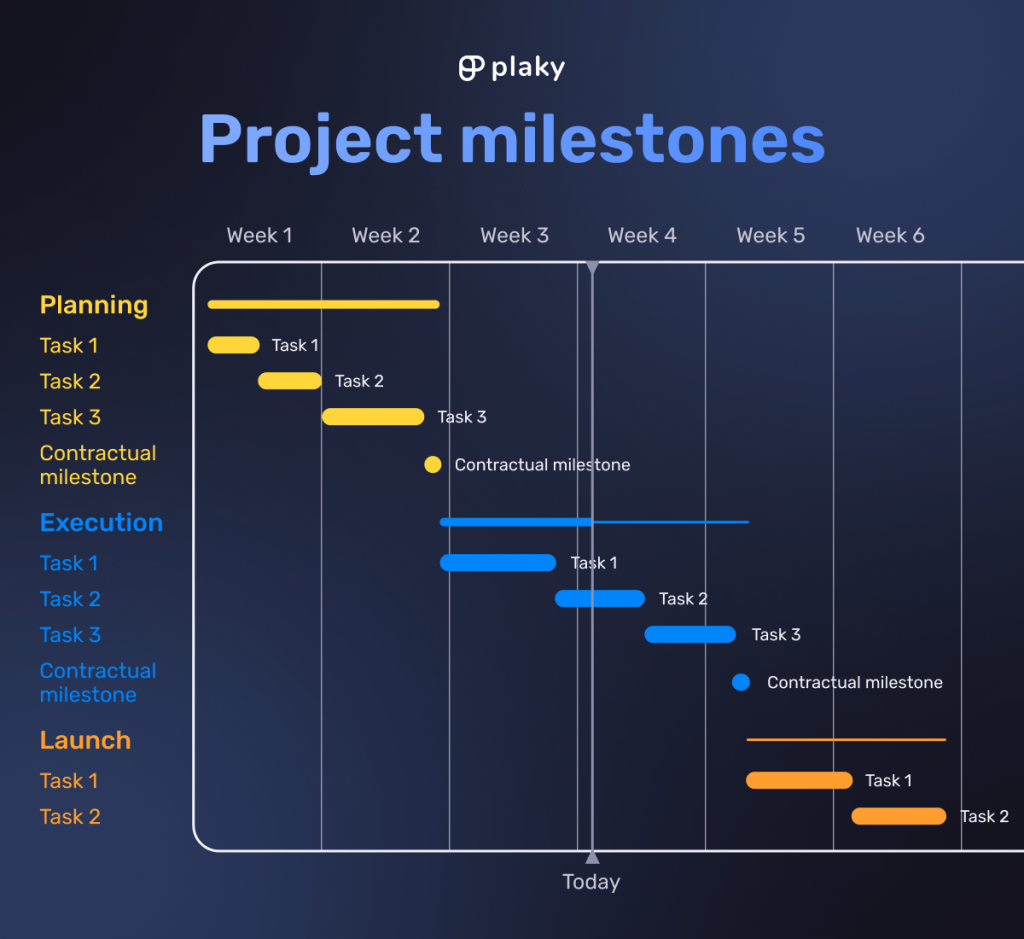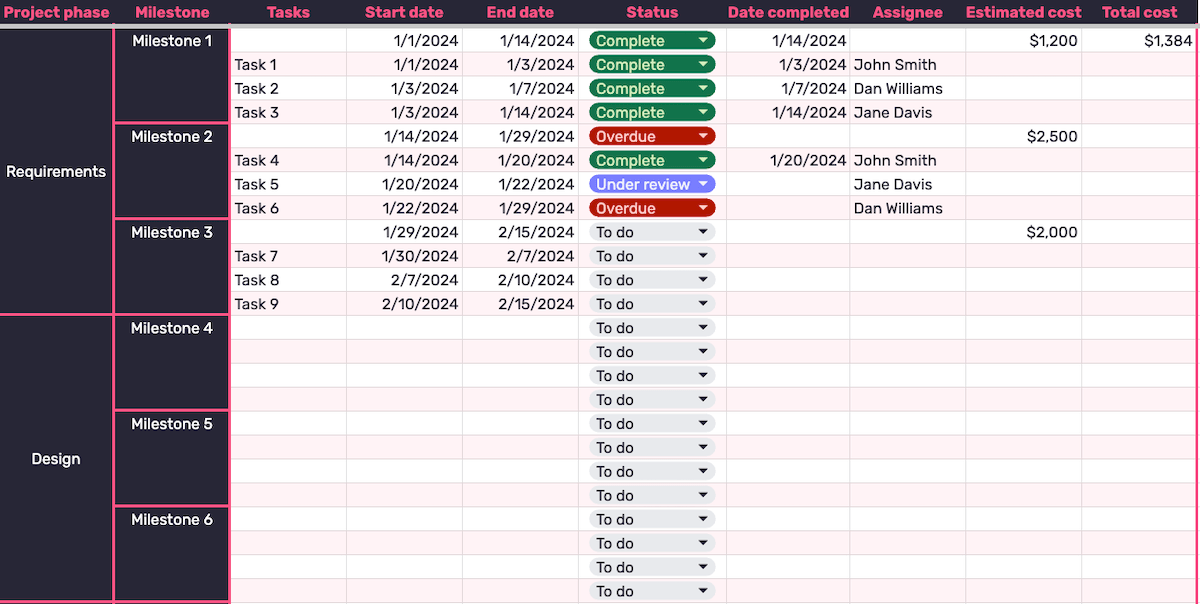What Are Project Milestones? (+ Examples and Free Template)
The term “project” covers a wide spectrum — from relatively simple sets of tasks handled by a small team to extremely complex undertakings that take several years and multiple companies to complete.
But no matter the scale of a project, the project manager must have some way to monitor its progress and ensure everything is going to plan. That’s where project milestones come in.
In this article, we will explain what project milestones are, and provide some examples, as well as some tips on how to best set milestones for your projects. Additionally, we’ll also provide some free templates you can use.

- Project management milestones are checkpoints used to signify tangible progress toward project goals and deliverables.
- They may coincide with the completion of a project phase or deliverable but are fundamentally different.
- Project managers can use milestones to break phases down into more manageable segments.
- Milestones are used in status reporting to provide stakeholders with more precise information on a project’s progress.
Table of Contents
What are project milestones?
A project milestone serves as a checkpoint or marker in the project timeline whose purpose is to demonstrate progress toward the project’s end goals and deliverables.
Furthermore, milestones allow project managers to break the project and its phases down into more manageable segments. In turn, this makes it easier to track important project KPIs and allows for better reporting and communication with the project stakeholders.
Looking at the 7th edition of the Guide to the Project Management Body of Knowledge (PMBOK), it defines a milestone as follows:
“Milestone. A significant event in a project, program, or portfolio.”
As you can see, milestones are not exclusive to project management, and they can be used to measure progress in other contexts as well.

Project milestones vs tasks
Milestones are important checkpoints that bear some indication of a project’s progression, whereas tasks are the most fundamental building blocks comprising every project.
Sometimes, milestones and tasks can be confused for one another — especially since the two are tied closely together.
Further, here’s the definition of a task from APM’s glossary:
“Task The smallest indivisible part of an activity when it is broken down to a level best understood and performed by a specific person or organization.”
With this in mind, it’s obvious that tasks and milestones could hardly be more different. In fact, milestones are usually dependent on a series of tasks that need to be completed before the milestone is met.
Project milestones vs goals
A “goal” is something that a project aims to achieve. Meanwhile, milestones are used to indicate just how far the project has progressed toward achieving said goals.
Here’s APM’s definition of goals, which makes a clear distinction between the two terms:
“Goal A one-sentence definition of specifically what will be accomplished, incorporating an event signifying completion.”
In other words, milestones are not what you aim to achieve, they are there to indicate that you have achieved your targets — including a project’s ultimate goals.
Project milestones vs deliverables
A deliverable is a finished product. Much like with project goals, milestones are used to indicate how far along the project has come in terms of making a particular deliverable client-ready.
Here’s how APM defines a deliverable:
“Deliverable A product, set of products or package of work that will be delivered to, and formally accepted by, a stakeholder.”
Just like with goals, the completion of a deliverable can be a milestone in itself. However, the deliverable is the product, and the milestone is just a checkpoint in your project management timeline that indicates its completion.
Project milestones vs project phases
Like with deliverables and goals, the completion of a project phase is commonly marked as a major milestone. Moreover, phases in more complex projects are often comprised of multiple milestones.
Here’s the project phase definition from PMBOK:
“Project phase. A collection of logically related project activities that culminates in the completion of one or more deliverables.”
Examples of milestones in project management
With all the basic definitions out of the way, let’s provide some concrete project milestone examples to illustrate what they look like in practice.
Example #1: Getting a project plan approved by stakeholders
Projects are often preceded by rigorous planning. For some projects, planning is the most important part of the process, as it details the timeline and resources required to execute the project successfully.
In such scenarios, having the project plan approved by the stakeholders can be a milestone in itself — it signifies that the project can move from the planning to the execution phase.
Example #2: Securing funding
Securing the required funding for your project is another example of a significant milestone, and it can be more complex than it seems at face value.
Sometimes, funding comes entirely from stakeholders who approve it at the planning stage, when the project manager presents the projected costs.
However, project funding can also come from a wide range of sources, such as:
- Third-party investors,
- Loans,
- Government grants, and
- Crowdfunding.
Moreover, some projects can be self-funded via an early launch, e.g., a software tool launching its beta version in early access.
💡 Plaky Pro Tip
Would you like to learn more about how project managers handle project finances? Take a look at the following articles:
Example #3: Obtaining required permissions or licenses
Most projects have to deal with government regulations and third parties in one way or another, and securing all the necessary permissions and licenses is another example of a major milestone in project management.
A construction project might need to get a number of permits from the local administration before work can begin.
Meanwhile, an IT project may need to obtain licenses for third-party software or meet certain regulations, such as the ISO 27001 standard for information security.
Example #4: Completing deliverables
It’s not unusual for a project to have more than one deliverable. In such cases, successfully completing one or several deliverables is a good example of a significant project milestone and a sign that the project as a whole is on track and proceeding as planned.
Here, a construction firm that’s working on a housing complex consisting of 4 buildings can treat the completion of each individual building as a deliverable.
An IT firm developing a software suite meant to compete with Microsoft Office or Google Workspace would be developing several standalone programs, and the completion of each one would be an important milestone.
Example #5: Filling important roles
Every project is a team effort, and there are many project roles that need to be filled. Successfully filling all the important positions on your project team is a great example of an important milestone, as it signifies the project can proceed to the next phase.
Similar to securing the financing for your project, hiring and retaining the right people is rarely as simple as it might seem on the surface.
Companies often spend a lot of time and resources on recruitment — the average cost is as high as $4,700 per person, according to a SHMRM recruitment cost research.
That said, it’s easy to see why filling all the vital positions is commonly seen as a major step forward in a project.
💡 Plaky Pro Tip
If you’d like to learn more about HR project management and recruitment processes, or the importance of retaining employees through positive employee experience, take a look at these articles:
How to decide what project milestones to track in your project
When deciding what milestones to track, the first and most important thing to consider is the project methodology you plan to use.
Milestones are especially important in projects that follow the traditional Waterfall project management approach, where the project can be divided into 5 distinct phases:
- Requirements,
- Design,
- Implementation,
- Verification, and
- Maintenance.
Each of these can be assigned a wide range of milestones based on the specific tasks found in each phase. As mentioned above, project managers can also use milestones to break down a phase into smaller, more manageable segments.
For projects based on the Agile framework that don’t proceed in linear phases and prefer flexibility over fixed schedules, milestones might be less obvious at first glance.
At Scaled Agile Framework, they list 3 types of milestones used in Agile projects:
- Program increment (PI) milestones — time-based milestones meant to objectively measure progress,
- Fixed-date milestones — time-sensitive milestones that have to be achieved before a specific date, and
- Learning milestones — milestones meant to validate technical and business opportunities relevant to the project.
Ultimately, if you’re wondering whether something is a fitting milestone for your project, consider the definition of a milestone and ask yourself:
- Is this event important?
- Does it represent tangible progress toward the project goals?
- Does it mark progress toward the completion of a phase or deliverable?
💡 Plaky Pro Tip
If you would like to learn more about different project management methodologies, take a look at the article below:
We posed this question to Jan Schiller, Partner and Chief Project Officer at Berkshire Consulting LLC , and she emphasized several important factors to keep in mind when creating milestones:

“I determine what milestones to set based on the nature of the project outcome, the organization’s project governance checkpoints, stakeholder perspectives, and the key deliverables that must be achieved on schedule in order for the outcome to be accepted. Milestones are nouns that make project schedule performance easier to accurately and predictably assess.”
How to set project milestones for your project
If you’re having trouble setting milestones, here are some tips that might help you in that respect.
In short, you should:
- Determine the goals, deliverables, phases, and tasks,
- Define each milestone clearly,
- Have the milestones approved by stakeholders,
- Maintain communication with the project team, and
- Keep track of progress and remain flexible.
Tip #1: Determine the goals, deliverables, phases, and tasks
As we have established, milestones are checkpoints used to measure progress and mark important events. And before you can set meaningful checkpoints, you have to consider exactly what you’re measuring.
So, before you can start setting milestones, you need to clearly outline the core building blocks of the project.
First, the project needs a defined goal. Then, it needs clearly outlined deliverables that will achieve that goal. To complete these deliverables, it’s necessary to break the project down into phases, tasks, and subtasks.
Once you have all of those core elements defined, you’ll have a much clearer picture of how best to set milestones to track progress within the project.
Tip #2: Define each milestone clearly
Before you make a milestone “official,” it’s important to ensure it’s clearly defined on all fronts. This includes:
- The tasks that comprise it,
- The list of criteria that need to be met for its completion,
- The description of the milestone, and
- The final deadline.
There should never be any room left for interpretation since any degree of uncertainty directly undermines a milestone’s purpose — they need to be clear-cut and set in stone (no pun intended).
Tip #3: Have the milestones approved by stakeholders
In addition to helping the project manager track progress and manage each project phase more easily, milestones also serve as a great means to keep the stakeholders in the loop.
As such, you should always get the stakeholders to approve any milestones you wish to set, as well as consider their input.
This way, the stakeholders will know what to expect and look forward to, and you will know exactly what you need to deliver. Plus, consulting the stakeholders on this matter can also provide insight into their mindset and priorities.
Tip #4: Maintain communication with the project team
There’s no understating the importance of efficient communication in all things related to project management, and milestones are no exception.
In fact, Jan Schiller considers it the most important part of the process:

“The most important step when setting milestones is to ensure they are regularly and consistently included in project communication regarding schedule progress. I show my project timeline as a diagram that is first produced when the project plan is baselined, and is updated to show actual complete dates (compared to planned target dates) for each project milestone at regularly scheduled project updates.”
We also talked to Noel Cabral, the Director at Main Sail, LLC, and he pointed out why communication is so important when it comes to project milestones:

“Accountability is a prominent factor in project management. Without it, project milestones lose their value. Thus, one should focus on accountability while creating project milestones. Foremost, taking input from the whole project team is a must. After all, one of the objectives of creating project milestones is to motivate them to do their best.”
He further illustrated the importance of communication when it comes to carrying work out efficiently and tracking progress:

“Also, they will become knowledgeable of their respective roles during the discussions. The project manager can let them know how they will track their work progress. It will prevent confusion during project implementation. And it will be beneficial for the project’s progress.”
With all that said, it’s essential to keep everyone in the loop so that the team members have a good idea of the goal they’re working toward, and so they can accurately report on their progress and keep the project as a whole on track.
Tip #5: Keep track of progress and remain flexible
As any seasoned project manager will confirm, things don’t always go according to plan. Milestones that you initially set might be late or prove non-viable altogether due to a variety of factors.
Here’s what Jan Schiller had to say on the subject:

“Project managers should avoid not updating the project plan based on actual progress (don’t put that project plan on a shelf; don’t let it collect dust). Project managers manage; they do not track. Be prepared to proactively provide insights to stakeholders when milestone target dates are missed.”
With this in mind, if you wish to avoid significant setbacks and stakeholder displeasure, it’s important to continuously monitor progress and be ready to adapt to unpredictable situations as they arise.
If milestones are repeatedly late or cost more than anticipated, it could just mean they were not set adequately. However, it could also indicate an underlying issue with the current plan and schedule that needs to be addressed, such as overambitious deadlines or scope creep.
💡 Plaky Pro Tip
For additional insight into how to plan projects more efficiently, take a look at the following articles:
When creating milestones as a project manager, what should you avoid?
Now, here are a few pointers on common pitfalls that you should avoid when setting milestones:
- Creating too many or too few milestones,
- Not spreading milestones evenly, and
- Confusing milestones with phases and tasks.
Mistake #1: Creating too many or too few milestones
There is no hard rule for how many milestones a project should have, as that is something extremely case-specific.
As such, inexperienced project managers could easily fall into the trap of creating more milestones than necessary — which would only end up being detrimental to the project by adding more unnecessary moving parts to keep track of.
Just the same, the project manager could also set too few milestones. As a result, they would be too sparse or too massive, and wouldn’t really fulfill their purpose.
To avoid this, be sure to focus only on the most important events during the project — with milestones, it’s quality over quantity.
Moreover, remember tips #3, #4, and #5 — even if there are too many or too few milestones from the outset, you can fix the issue through regular monitoring and communication with stakeholders and team members.
Mistake #2: Not spreading milestones evenly
Another common issue that might arise is that milestones might not be set up evenly — there might be too many milestones at critical points, with too few throughout the rest of the phase or project.
If you have too many potential milestones in a small timeframe, try and use only the most important ones.
And if you have too few, consider the important events in that part of the project timeline — the tasks here might not seem important compared to those at the end of the phase, but you should still see which of them would make a notable milestone for your team to work toward.
Remember that milestones should be progressive and evenly spaced in order to maintain morale and forward momentum in the team.
Mistake #3: Confusing milestones with phases and tasks
As we’ve established, it’s easy to confuse milestones with other important elements that comprise a project, mainly tasks and phases.
To avoid confusion and to make sure milestones are used properly, be sure to remember what tasks and phases are:
- Tasks are the base building blocks of a project that outline what team members should be working on.
- Phases are a collection of tasks that culminate in the completion of a deliverable.
To avoid confusion, remember that milestones are a checkpoint that marks the completion of a group of tasks and that phases are usually broken down using multiple milestones.
Project milestone template
If you’d like to track milestones more accurately but don’t want to invest in project management software, here is a useful customizable template you can try.
🔽 Project milestones template — Tracker with timeline
With this sheet, you can:
- List all your milestones and their tasks,
- Set start and end dates,
- Track actual completion dates,
- Track their status from several dropdown options, and more.
You can select the fields listing the milestones and their start and end dates, click “Insert,” and choose the “Timeline” option. Then, the sheet will automatically create a new page with an easy-to-review timeline of all your milestones.

💡 Plaky Pro Tip
Further, here are some additional project timeline templates you might find useful:
Why should you use project milestones? What’s their importance?
With all that said, it’s clear that project milestones fulfill several important functions in project management:
- They allow project managers to plan and adapt more efficiently by grouping tasks into meaningful wholes within a given project phase.
- They allow for easier and more accurate status reports, which helps build trust with stakeholders.
- They provide team members with tangible short-term goals to work toward, which helps maintain productivity and improve morale.
💡 Plaky Pro Tip
You can track project milestones by creating your own Gantt chart in Google Sheets or Excel. Here’s how:
Conclusion: Project milestones are the key to accurate progress tracking and reporting
All things considered, milestones are an important tool in any project manager’s arsenal.
So long as they are used appropriately and not conflated with other related project management terms, they are an excellent way to ensure a project stays on track and that all involved parties are up to date on its progress.
📖 We’ve explained what project milestones are and how they differ from some other important terms it might be confused with. However, these aren’t the only potentially confusing terms for new project managers, so it’s best to visit the Project Management Glossary of Terms, where you can find explanations for a wide range of project management terminology.
References
- Association for Project Management. (n.d.). APM glossary of project management terms. https://www.apm.org.uk/. Retrieved October 25, 2023, from https://www.apm.org.uk/resources/glossary/
- Navarra, K. (2022). The Real Costs of Recruitment. https://www.shrm.org/. Retrieved October 24, 2023, from https://www.shrm.org/resourcesandtools/hr-topics/talent-acquisition/pages/the-real-costs-of-recruitment.aspx
- Project Management Institute. (2021). Glossary. In A guide to the Project Management Body of Knowledge (PMBOK guide) (pp. 243–243).
- Scaled Agile Framework (n.d.). Milestones. https://v5.scaledagileframework.com/. Retrieved October 23, 2023, from https://v5.scaledagileframework.com/milestones/
 Project Management Hub
Project Management Hub 











